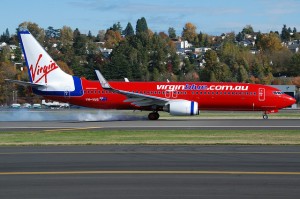In the unlikely event you have a very crazy flight, these flight attendants are making sure you will be prepared.
Browsing Tag: flight attendant
How much more innocent can you get than a game of peek-a-boo? Well it is not so innocent when a child ended up locked in an overhead bin on a recent Virgin Blue flight.
Natalie Williamson says her and her 17month son and husband were on a Virgin Blue flight from Fiji to Sydney, when the fun game turned serious. The husband (who is now estranged) was playing a fun little game of peek-a-boo with their child, Riley when one of the flight attendants decided to join in. She thought it would be a good idea to put Riley into the overhead bin and shut the door. Bad call.
“My husband, Shayne, was standing one metre behind my son, Riley, when the air steward picked him up and placed him in the overhead compartment,” Natalie told the Herald Sun. She stated that people around her were laughing and found it funny, but found it very disturbing.
The airline has confirmed that the the flight attendant did put Riley into the overhead bin and has since been fired. Virgin Blue offered Natalie free flights for having to deal with the bad situation, but that doesn’t seem to make things okay in her eyes.
For most people this might become a story to tell, but Natalie is saying that things for Riley aren’t going too well. She states that he is having trouble sleeping and won’t leave her side. “If I’m not in the same room as him, he will scream and yell ‘Mum, mum, mum’,” she said.
It sounds like the flight attendant messed up, but enough to deserve a firing? Well, I guess we don’t know if the flight attendant has other mess ups. I am no counselor, but it seems a bit odd that Riley would have so many issues after only a few seconds in the overhead bin. Either way I don’t think other flight attendants should try this game with other kids anytime soon.
Found via AOL Travel News Image: Andrew Sieber
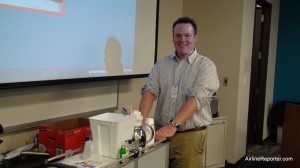
That's me, trying out the service cart. Not as easy to handle as it looks and I really should have a second person helping me.
The last two days I have talked about how flight attendants at AirTran learn a lot about safety. Luckily most passengers will never see the safety training in action, but they will see in-flight training in action on every flight.
Flight attendants provide a welcoming environment for passengers and can be the only contact a person has with an airline. Nowadays, with being able to buy tickets and check in online then go right to the gate, passengers don’t interact with other airline employees that often. This means a smile and a positive attitude can go a long way. Sometimes it can be difficult to smile after having a long day and dealing with difficult passengers.
Being a server at a restaurant can be a challenging job. You should try it at 30,000 feet, locked in a rocking cylinder with over 150 customers. It might just look like flight attendants come down the aisle and give you a drink and some peanuts, but it is a bit more complex than that. The process of getting passengers their drinks and snacks starts when the airplane pulls up to the gate.
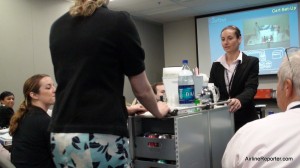
Practicing pushing the cart in the classroom.
While passengers prepare to board, the catering company will load stocked service carts on the plane. Even though catering companies do a great job of properly loading the carts, it is important for flight attendants to double check. Could you imagine what would happen if there wasn’t any ice on the cart? Passengers would start a riot.
After it is confirmed the carts are properly stocked, it is time to start taking care of the Business Class passengers. The folks up in the front of the plane pay a premium and get the benefit of being offered a drink before the flight takes off. They also receive a higher level of service.
During boarding, it can be a juggle for flight attendants. They welcome people boarding the plane, take orders from Business Class, fill those orders, keep up with the announcements, help passengers find their seats, and work with the overhead bins. There are three flight attendants, but it is a lot to get done before the plane is ready to leave.
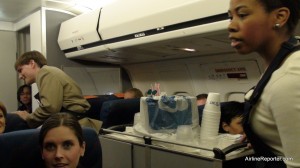
Game time! Newbie flight attendants try out their new skills in the mock Boeing 717.
The flight attendant working the front of the plane also needs to make sure they keep tending to the Business Class passengers and pick up any trash before take off. This can be a challenge weaving through boarding passengers.
After trash is picked up, a flight attendant’s job turns back to making sure the passengers take off and reach cruising altitude safely.
Once the plane hits 10,000 feet on AirTran, you can hear the pilot say, “Flight Attendants, departure check.” It is time for the flight attendants to prepare for the flight service. At this time they will also announce that electronic devices can be used. Getting the cart safely out of its housing and preparing it can be quite a challenge, since the aircraft is only at 10,000 feet and still rapidly climbing to around 30,000.
AirTran’s drink selection is quite vast, which means drink orders can get a little more complicated than just “Diet Coke please. ” Since there are so many alcoholic options, the flight attendant also becomes a mini-bartender.
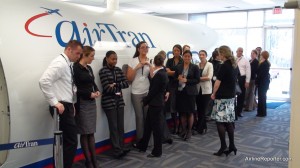
The Newbie Flight Attendants wait outside the mock Boeing 717 to be boarded for their fake flight to no where.
In the training, the flight attendants learn some of the most commonly ordered alcoholic drinks. Luckily they don’t have to make anything too complex, but they want to know what a screw driver is when a passenger asks.
Most AirTran flights have two alcohol kits which holds 70 small alcohol bottles each. Flights to Las Vegas will have three kits, since more alcohol is consumed on those flights on average (and probably need more aspirin for flight from Las Vegas).
Even though there is plenty of alcohol aboard the plane, flight attendants are trained how to respectfully tell a customer that they have had enough to drink. We often hear or read about some passenger getting unruly and it being directly related to alcohol. The high altitude and dry air of the airplane can make passengers feel the affect of alcohol much quicker than on the ground. If a passenger has too much to drink, flight attendants don’t want to create a situation with a drunk and angry passenger by bluntly stating a passenger is too drunk to drink more. Instead, they are trained to politely suggest another type of (non-alcoholic) drink or hint that it might seem the altitude has affected them a little hard.
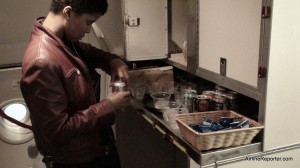
Getting cups with ice ready and opening drinks you know will be popular (ie Diet Coke) can save time!
There are also specific rules on how to ask passengers if they want a drink. Ladies in a row will be asked first, then passengers in the window seat, middle, and aisle seat last. The plane will be served from the rear of the aircraft to the front. These are things that most people would never notice, but it is something every flight attendant must be aware of (probably the ’œmagic’ of in-flight service will be ruined a little since I will now notice all of these little things).
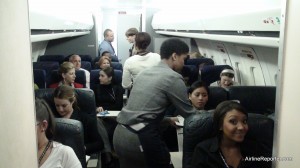
The inside of the mock Boeing 717 with new flight attendants waiting to be served.
Flight attendants must also be aware what time the flight was scheduled to depart. If the flight was scheduled to depart before 10am, that means they are to give out AM snacks and after 10am means passengers will get PM snacks. That seems easy enough, but when you are traveling all over the country or even the world, it can get a bit more complicated.
If the flight is short, there will only be one service, but if the flight is longer, there can be a few services performed in the main cabin. Once the first is done, flight attendants must start to prep for the next. It can be tedious work, but it keeps them busy and out there connecting with passengers.
Learning all of this in the classroom was helpful, but trying it first hand is much more important (and more fun). After a few hours in class, we all headed down the hall to the mock Boeing 717. Being in the mock aircraft seemed to be every one’s favorite (I know I liked it and I got to play with all the buttons). The newbie flight attendants got to practice all their speeches and in-flight service procedures. They actually served real drinks to other classmates (no alcoholic ones), but I was too busy running around getting photos (something that would most likely get me in trouble in a “real” plane) I didn’t get to be served a drink.
I was impressed with how complex just one day of in-flight training was and have a new respect for flight attendants. From what I saw, it looks like AirTran will have a great batch of new flight attendants who should be taking to the skies in the next few weeks, as well as be ready to greet you with a smile!
A Day In The Life Of…A Training Flight Attendant
PART 1 | PART 2 | PART 3 | PART 4 | PART 5 | ALL | PHOTOS
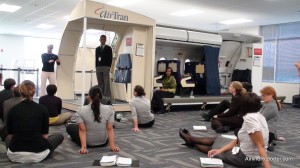
Class of new flight attendants learning how to open and close the main cabin door.
Every time you board an airline you are greeted (at least should be) by a friendly flight attendant. You will also see them serving you drinks, snacks and, if you are lucky, a meal. However, their job is so much more important than the things you see on an average flight. I think each of us frequent fliers feels as though we have a good idea of what a flight attendant’s job duties are. However, I wanted to see what they are taught first hand.
Recently, given the opportunity to see AirTran flight attendants train, I flew down to their flight attendant training program in Atlanta, GA in order to hang out for two days and get to see some of the training each of their flight attendants receive. I was surprised how much I learned in the two days I was down there.
During my visit I was able to see and experience the two main aspects of a flight attendant’s job: taking care of the customers and safety. Luckily airline accidents are rare and most people don’t have to see a flight attendant’s safety training in action, but that training is extremely important.
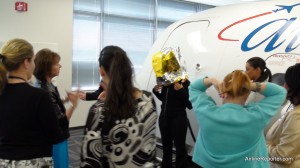
Current flight attendants putting on full head gear to use while putting out a fire.
There were two classes that I kept bouncing back and forth between. One was a group of new hires (I shall call them “the newbies“) who were about two weeks into their four week training and the other group was current flight attendants (I shall call them “the pros“) who were training just for one day.
The newbies were mostly going through customer service and in-flight service training whereas the pros were practicing different safety procedures. Seeing both sides really let me know how important both aspects are to being a great flight attendant.
Hopefully most people will never have to witness a flight attendant’s safety training kick in, but it could help to save your life someday. During the time I was following the pros around I witnessed them practice putting out fires and providing first aid. They have to know which type of extinguisher to use on specific types of fires, how to make the extinguisher work, when to put on the full head gear and how to properly put out a fire. This stuff is much more complex than just pouring a cup of coffee.
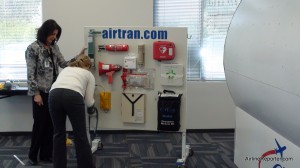
Practicing how to use all the safety equipment and hoping they won't ever have to use it.
While hanging out with the newbies, watching them learn where safety items are located on an aircraft, I asked on Twitter, “Anyone guess the 5 things checked by #AirTranFA [flight attendants] in the [lavatory] during preflight?”
Most people responded with things like, “check the soap level,” or “make sure it is clean.” Although, yes that might be part of their job, no one really answered any safety related questions. Here are the five things they have to check:
1) Make sure the smoke detector is operating.
2) Check the trash lid to make sure it automatically closes. This is because passengers will try to smoke in the lavatories (big no-no) and put their cigarettes out in the trash, which can catch fire.
3) Make sure the fire suppressant system for the trash is full (a bit off topic: I heard a story that some passengers will hover over the toilet and blow smoke down the drain to avoid being detected).
4) Look to see that the “No Smoking” place cards are still there.
5) Make sure the ashtray is functioning. This might seem silly for why there is an ashtray, but in reality passengers will try to smoke on flights and if they do and the alarm goes off, they want them to properly dispose of the cigarette instead of putting it in the trash and possibly starting a fire.
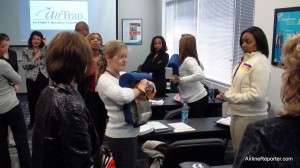
Practicing to make your seat cushion your best friend.
The five items to check in the lavatory are just one example of the many things that flight attendants do, that passengers have no idea about.
Yes, they are going to make sure the bathroom is ready for you to use, but they also make sure it will be a safe flight.
Back in the day, flight attendants had to be nurses. In case something happened mid-flight, they could then assist the passengers. Even though being a nurse is no longer a requirement, they must still be trained in proper CPR procedures. In most cases there will be a trained nurse or doctor on a flight that will be able to assist a passenger in trouble, but if not, flight attendants are trained to keep a sick passenger alive until the flight can land.
Another part of training that the pros went through, was practicing how to handle a plane ditching into the water. Tomorrow I will post about this experience. I don’t want to ruin it, but it involves darkness, smoke, and screaming.
A Day In The Life Of…A Training Flight Attendant
PART 1 | PART 2 | PART 3 | PART 4 | PART 5 | ALL | PHOTOS
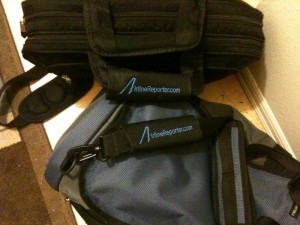
My custom luggage handles...yes I am a nerd.
I am sitting at Seattle-Tacoma International Airport once again (and enjoying their free wi-fi). I am off to Atlanta to do some cool things with AirTran for the next few days. Just in time, I have been getting that desire to get airborne again!
I am going to learn some aspects of being a a flight attendant at AirTran’s training facility, which will kick off a new series on my blog where I explore different airline related jobs. You can expect some blogs on my adventure in the near future and until then follow my Twitter.
Because of scheduling I am actually going to be flying a red-eye on US Airways to Charlotte, then down to Atlanta. It will be a long night, but who needs sleep? US Airways just announced they have started providing GoGo Inflight WiFi on a few of their Airbus A321’s. Just so happens I am flying a A321 to Charlotte. Part of me hopes it doesn’t have WiFi so I can get some sleep.
